Sparrowhawk, a term commonly used to refer to various species of small to medium-sized birds of prey, embodies agility and predatory prowess.
With a distinctive appearance characterized by sharp talons, keen eyesight, and a robust build, Sparrowhawks are renowned for their adept hunting skills and efficient flight capabilities.
These birds belong to the Accipiter genus and are distributed globally, inhabiting diverse ecosystems ranging from dense woodlands to urban environments.
Known for their stealthy nature and rapid, unpredictable flight patterns, Sparrowhawks primarily feed on small birds and occasionally engage in impressive aerial displays during courtship.
Their role as apex predators contributes to ecological balance, regulating prey populations in their respective habitats.
The enigmatic and adaptable Sparrowhawk serves as a captivating subject of study, illuminating the intricate dynamics of avian ecology and the fascinating interplay between predator and prey in the natural world.
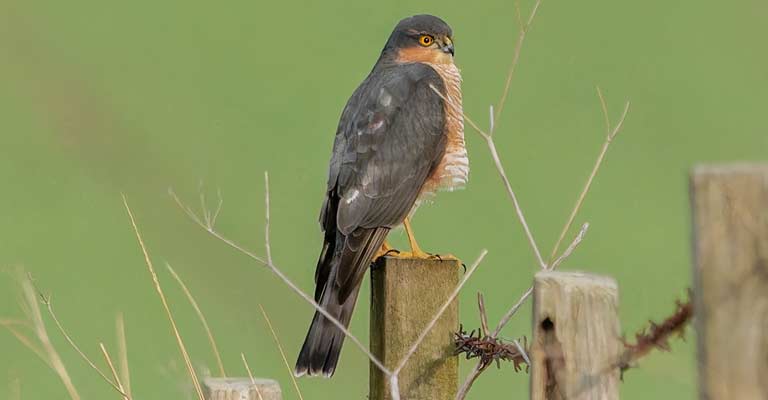
Identifying Characteristics of Sparrowhawk
Identifying the Sparrowhawk amidst the avian realm requires a keen eye and an appreciation for the subtle nuances that distinguish this bird of prey.
From physical features to behavioral traits, here are eight key points to help identify the Sparrowhawk:
Size and Build
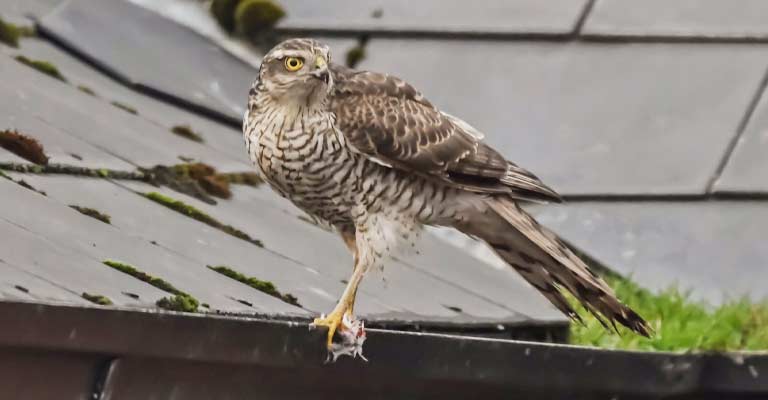
Sparrowhawks exhibit a compact and robust build, generally smaller than other raptors like eagles or hawks. They fall within the range of small to medium-sized birds of prey, with females being larger than males.
The wings are relatively short and rounded, contributing to their agile and maneuverable flight.
Distinctive Plumage
The plumage of Sparrowhawks showcases a striking combination of colors and patterns.
Typically, they have a mix of dark and light feathers on their back, with males often displaying bluish-gray upperparts and orange-barred underparts. Females, on the other hand, feature a brownish coloration with darker streaks.
Facial Features
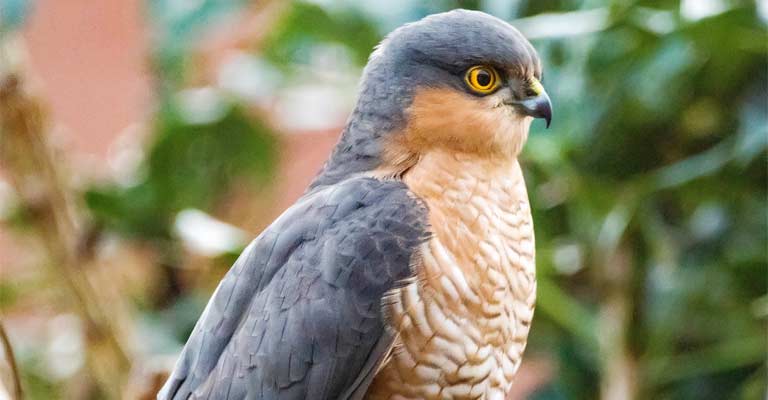
The facial features of Sparrowhawks are characterized by a keen and intense gaze.
Their eyes are large and forward-facing, aiding in precise depth perception during hunting. The hooked beak is sharp and powerful, facilitating the efficient tearing of prey.
Tail Configuration
A notable feature aiding in Sparrowhawk identification is their tail configuration. The tail is relatively long and squared at the tip, contributing to their acrobatic flight.
The distinctive tail shape becomes particularly evident when observing these birds in flight.
Flight Pattern
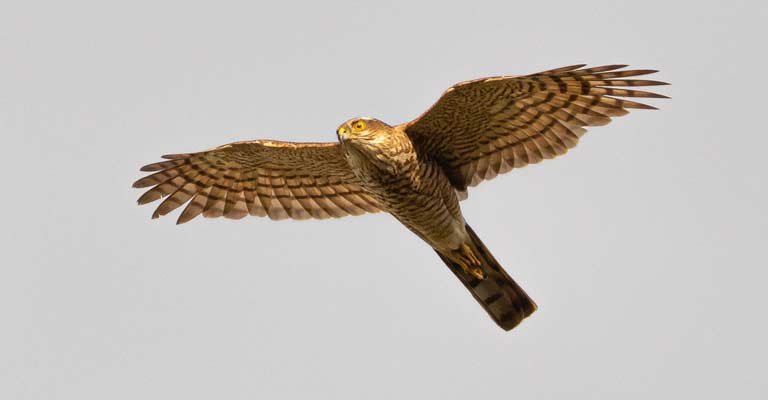
Sparrowhawks are renowned for their rapid and agile flight. When in pursuit of prey, they engage in sudden bursts of speed and demonstrate remarkable maneuverability.
Their flight pattern often involves low, undulating flights through dense vegetation as they navigate obstacles with finesse.
Habitat Preferences
Understanding the habitat preferences of Sparrowhawks is crucial for identification. These birds are adaptable and can be found in a variety of environments, including woodlands, forests, and urban areas.
Observing their choice of habitat can provide valuable clues for identification.
Distinctive Call
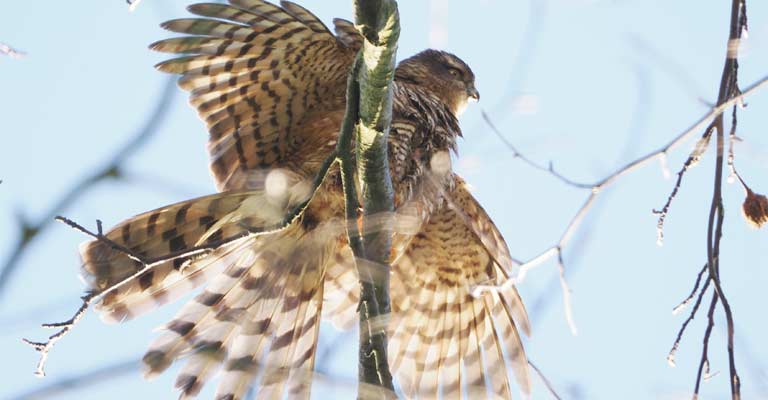
The Sparrowhawk’s vocalizations serve as another key identifier. Their calls are high-pitched and sharp, often described as a “kek-kek-kek” sound.
Familiarizing oneself with these distinct calls can enhance the accuracy of Sparrowhawk identification, especially in areas with multiple bird species.
Hunting Behavior
Sparrowhawks are skilled hunters, primarily preying on small birds. Observing their hunting behavior, characterized by sudden, agile movements and stealthy approaches, can further aid in identification.
Their strategy often involves surprise attacks, utilizing cover and obstacles for successful captures.
Identifying Sparrowhawks involves a comprehensive assessment of their physical characteristics, behavior, and habitat preferences.
By paying attention to these key points, bird enthusiasts and ornithologists can develop a nuanced understanding of this remarkable bird of prey within the rich tapestry of avian biodiversity.
Taxonomy of Sparrowhawk
Here is a table on the Taxonomy details of Sparrowhawk:
| Taxonomic Level | Classification |
| Domain | Eukaryota |
| Kingdom | Animalia |
| Phylum | Chordata |
| Class | Aves |
| Order | Accipitriformes |
| Family | Accipitridae |
| Genus | Accipiter |
| Species | Sparrowhawk |
The Sparrowhawk, scientifically known as Accipiter nisus, is a species of bird of prey with a widespread distribution.
Within this species, several distinct subspecies exhibit subtle variations in size, plumage, and geographic range. Here are brief descriptions of some of the closely related Sparrowhawk subspecies:
Little Sparrowhawk (Accipiter nisus badius)
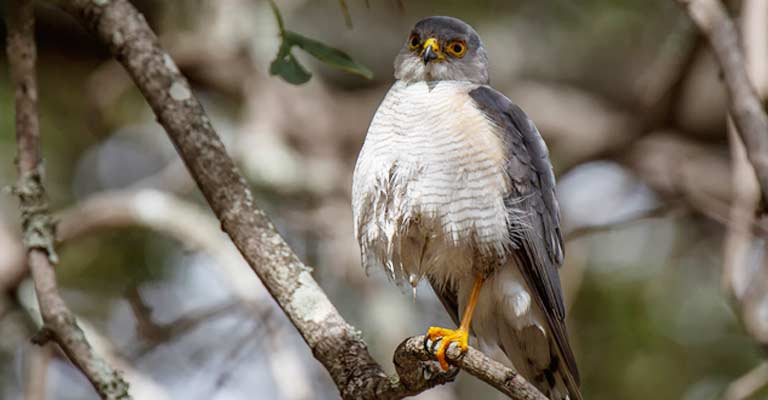
The Little Sparrowhawk, a subspecies of the Eurasian Sparrowhawk, is characterized by its smaller size.
Found in parts of Southeast Asia, its plumage shares similarities with the Eurasian Sparrowhawk but tends to be more rufous in coloration.
Levant Sparrowhawk (Accipiter nisus granti)
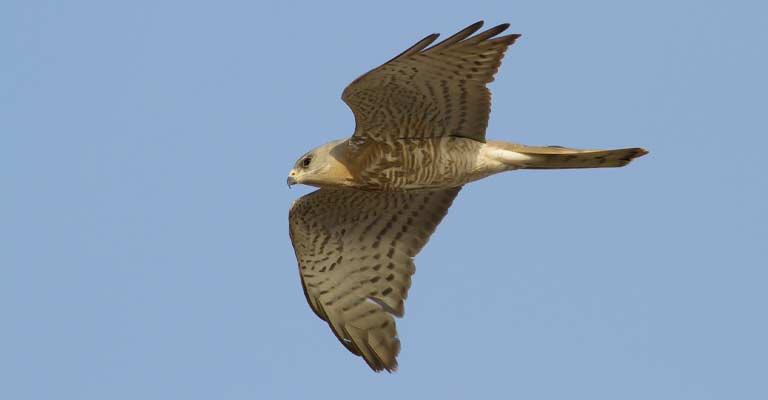
The Levant Sparrowhawk inhabits regions in the Middle East, particularly around the Levant.
This subspecies exhibits variations in size and plumage compared to its counterparts, reflecting adaptations to its specific geographic environment.
Japanese Sparrowhawk (Accipiter nisus orientalis)
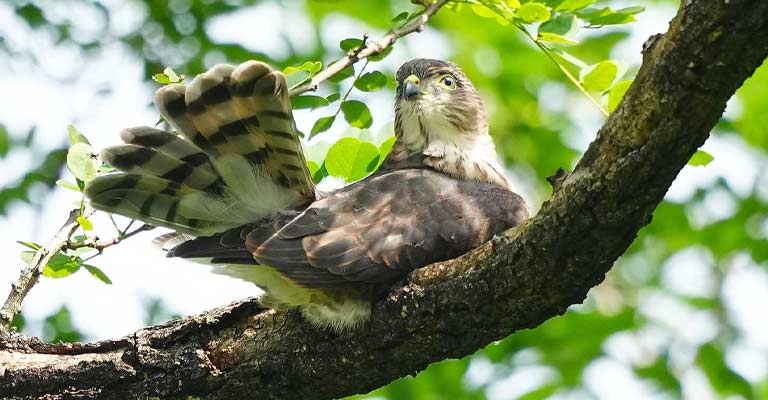
Endemic to Japan, the Japanese Sparrowhawk is a distinctive subspecies with notable size and plumage differences. These birds are adapted to the unique ecological conditions of the Japanese archipelago.
Chinese Sparrowhawk (Accipiter nisus melaschistos)
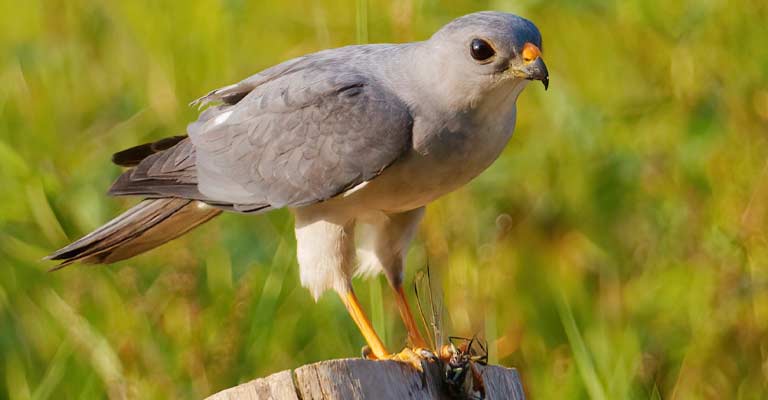
Found in China and surrounding areas, the Chinese Sparrowhawk showcases characteristics that set it apart from other subspecies. Its plumage may vary, and it is adapted to the diverse landscapes of China.
Eurasian Sparrowhawk (Accipiter nisus nisus)
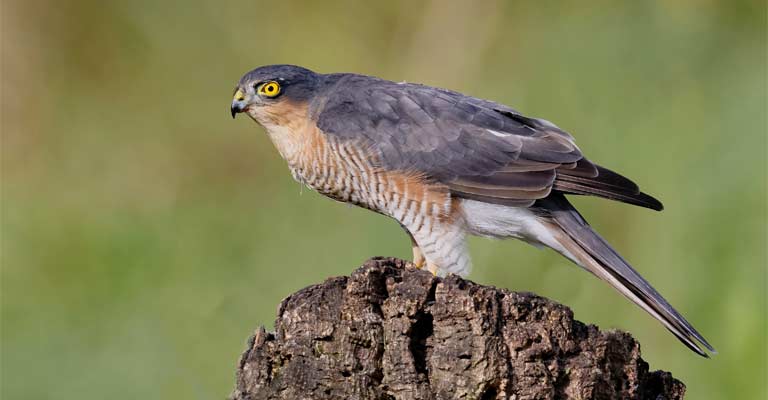
The Eurasian Sparrowhawk represents the nominate subspecies and is widespread across Europe and Asia.
With a combination of grayish-blue upperparts and orange-barred underparts in males, and brownish coloration in females, this subspecies serves as the baseline for the species.
Collared Sparrowhawk (Accipiter cirrocephalus)
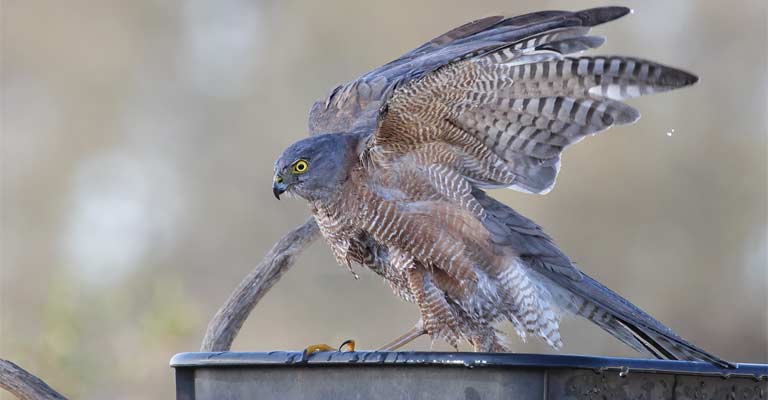
The Collared Sparrowhawk is a bird of prey found in Australia and New Guinea. It is recognized for its striking plumage, which includes a distinctive, bold collar-like pattern on the nape.
With a preference for woodland habitats, this species is known for its agility in flight and adept hunting skills, primarily targeting small birds.
Rufous-breasted Sparrowhawk (Accipiter rufiventris)
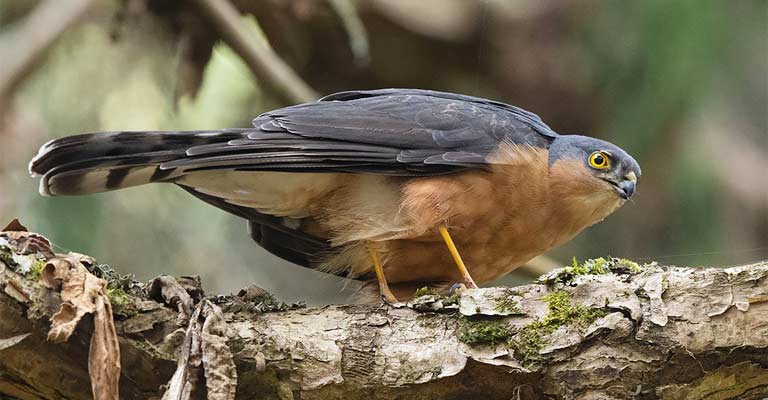
Endemic to Africa, the Rufous-breasted Sparrowhawk is identified by its rufous-colored breast and belly. This species inhabits forests and wooded areas, preying on a variety of birds.
The distinctive plumage, combined with its swift flight, makes it an intriguing member of the Accipiter genus.
Slaty-mantled Goshawk (Accipiter luteoschistaceus)
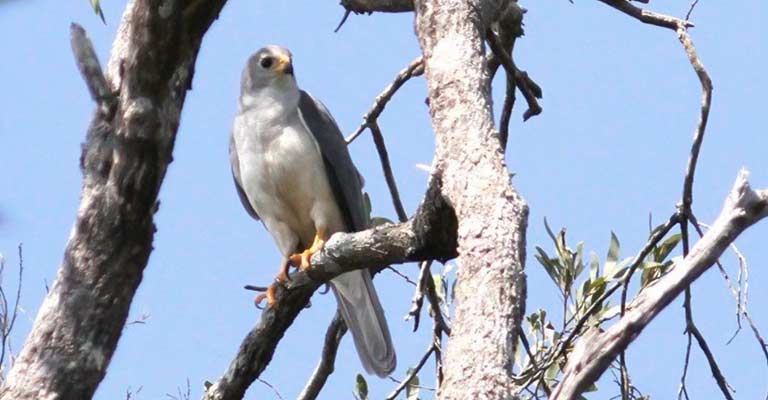
The Slaty-mantled Goshawk, native to New Guinea, is recognized for its slate-gray mantle and distinctively colored plumage. This species is often found in montane forests and exhibits a preference for higher elevations.
Its hunting prowess is demonstrated through stealthy approaches and agile flight.
Black Sparrowhawk (Accipiter melanoleucus)
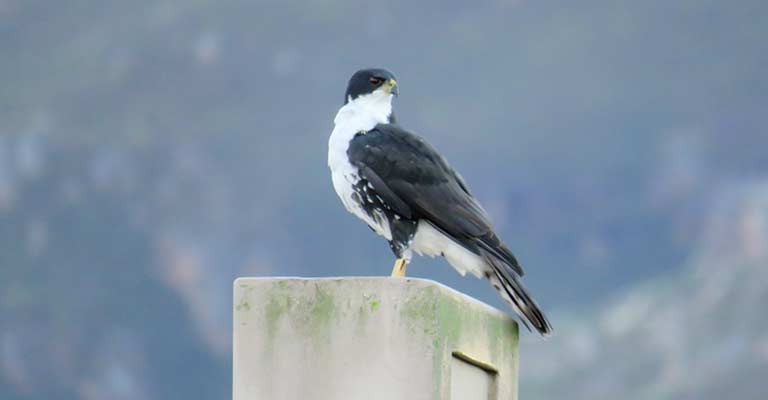
Indigenous to sub-Saharan Africa, the Black Sparrowhawk is characterized by its predominantly dark plumage. The adult males display a blackish coloration, while females and juveniles exhibit a brownish hue.
With a broad distribution, this species is adaptable to various habitats, including forests and savannas.
Ovambo Sparrowhawk (Accipiter ovampensis)
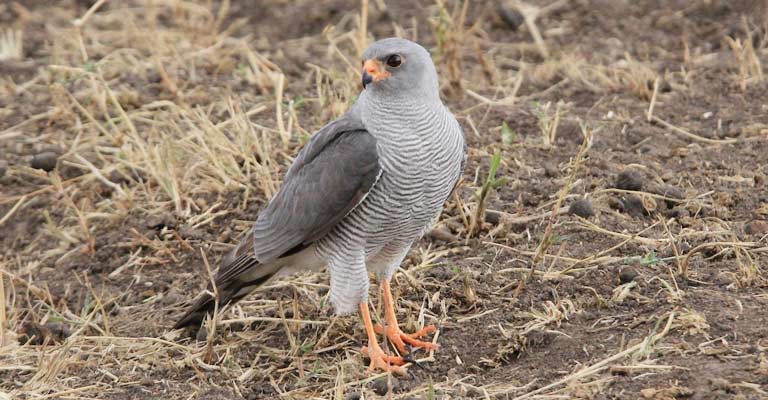
Endemic to southwestern Africa, the Ovambo Sparrowhawk is named after the Ovambo people of Namibia. This species prefers savanna and woodland environments.
Its plumage varies, with adults displaying a mix of dark and light feathers. Known for its swift and skillful hunting, the Ovambo Sparrowhawk is an integral part of the region’s avian diversity.
While these Sparrowhawk subspecies share a common evolutionary lineage and core characteristics, their adaptations to diverse habitats and geographic locations have resulted in unique traits.
The variations in size, plumage, and distribution among these subspecies offer a fascinating insight into the adaptive nature of this versatile bird of prey across different regions of the world.
Sparrowhawk Life History
The Sparrowhawk (Accipiter nisus), a captivating bird of prey, unfolds its life history through a remarkable interplay of adaptation and instinct.
This agile raptor, known for its swift flight and adept hunting skills, navigates a diverse array of habitats across its expansive range.
From the intricacies of nesting and breeding to the challenges posed by diseases, the Sparrowhawk’s life history provides a fascinating glimpse into the dynamics of avian ecology and conservation efforts.
Food
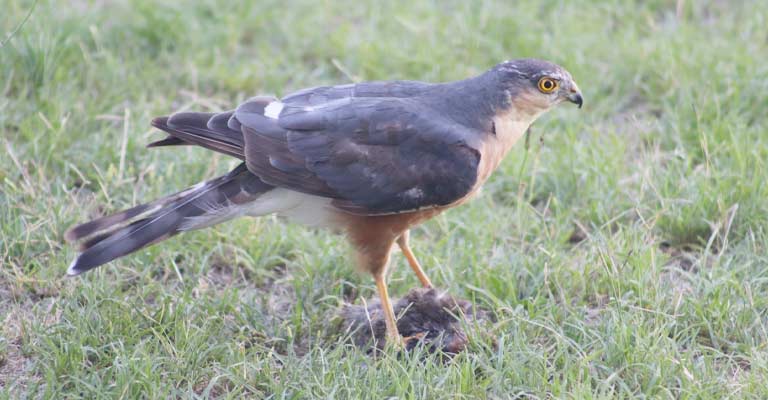
Sparrowhawks are voracious hunters, primarily preying on small birds. Their diet may include sparrows, finches, thrushes, and other songbirds, showcasing a keen ability to navigate dense vegetation in pursuit of agile prey.
This predilection for avian targets underlines their role as apex predators, regulating bird populations within their ecosystems.
Habitat
Versatile and adaptable, Sparrowhawks inhabit a range of environments, from woodlands and forests to urban areas.
Their choice of habitat is often influenced by the availability of prey, providing these raptors with the flexibility to thrive in diverse landscapes across Europe, Asia, and parts of Africa.
Range Map

The Sparrowhawk’s range spans a vast geographical expanse, covering Europe, Asia, and portions of Africa.
A range map intricately details their distribution, highlighting the interconnectedness of ecosystems that these birds play a vital role in regulating.
Nesting
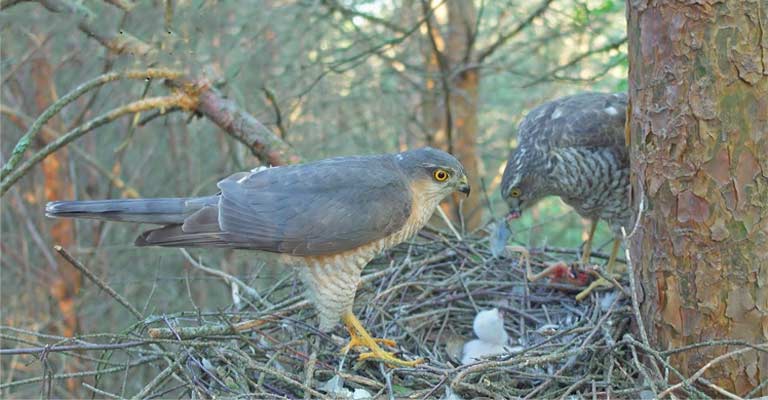
Nesting behavior varies among Sparrowhawks, typically choosing concealed locations within dense vegetation for their nests. The female takes charge of nest construction, using twigs and lining the interior with softer materials.
Nesting sites are strategically chosen to provide ample cover and protection for the vulnerable eggs and chicks.
| Nesting Details | Information |
| Clutch Size | 3-7 eggs |
| Number of Broods | Typically one per breeding season |
| Egg Length | Approximately 36-45 mm |
| Egg Width | Approximately 28-36 mm |
| Incubation Period | Around 31 days |
| Nestling Period | Approximately 21-28 days |
| Egg Description | Whitish to pale blue-green with light spots |
| Nest Construction | Built by the female with twigs and soft lining |
| Nest Location | Concealed in dense vegetation or tree branches |
| Parental Involvement | Both males and females contribute to incubation and care |
| Fledgling Independence | Gradual, young people become more independent over weeks |
Breeding
The breeding season sees courtship displays, with males engaging in impressive aerial acrobatics to attract females. Once a pair forms, they collaborate on nest-building and share incubation duties.
Clutches typically consist of 3-7 eggs, and the chicks hatch after about a month. The fledglings remain dependent on parental care before gradually gaining independence.
Diseases
Like any wildlife species, Sparrowhawks are susceptible to diseases, with avian pox and trichomoniasis being common concerns.
These diseases can impact the health and reproductive success of individuals within populations, necessitating a nuanced understanding of their prevalence and effects.
Treatment
Mitigating the impact of diseases on Sparrowhawk populations involves comprehensive monitoring, research, and potential intervention strategies.
Veterinarians and wildlife experts work towards understanding the pathogens affecting these birds, implementing treatment protocols, and promoting overall ecosystem health to bolster resilience against disease outbreaks.
Conservation
Conservation efforts for Sparrowhawks focus on preserving their habitats, ensuring prey availability, and addressing potential threats such as habitat loss and human-wildlife conflicts.
Collaborative initiatives involving researchers, conservationists, and communities aim to safeguard these raptors and maintain the delicate balance they contribute to within ecosystems.
In unraveling the life history of the Sparrowhawk, we gain insights into the intricate web of ecological relationships that define its existence.
From the subtleties of foraging to the challenges of disease management, the story of the Sparrowhawk underscores the importance of holistic conservation approaches to ensure the continued vitality of this remarkable bird of prey.
10 Fun Facts About Sparrowhawk
The Sparrowhawk, with its agile flight and predatory prowess, is a fascinating bird of prey that captivates bird enthusiasts and ornithologists alike. Here are 10 fun facts that shed light on the intriguing nature of these remarkable raptors:
- Size Discrepancy: Male Sparrowhawks are notably smaller than their female counterparts. This size difference, known as sexual dimorphism, is unusual among raptors, where females are typically larger.
- Stealthy Hunters: Sparrowhawks are renowned for their stealthy hunting techniques. They navigate through dense vegetation with remarkable agility, surprising their prey with sudden and swift attacks.
- Urban Adaptability: Unlike many birds of prey, Sparrowhawks display a remarkable adaptability to urban environments. They can be found in city parks and gardens, showcasing their ability to coexist with human habitation.
- High-Speed Pursuit: Sparrowhawks are adept at high-speed pursuits during hunting. Their rapid flight and sudden maneuvers allow them to catch small birds in mid-air, showcasing their exceptional aerial skills.
- Distinctive Plumage: Male Sparrowhawks exhibit striking bluish-gray upperparts and orange-barred underparts, while females and juveniles display brownish hues. These distinctive plumage patterns aid in species identification.
- Vocal Mimicry: Sparrowhawks are known to mimic the calls of other birds, a behavior observed mainly in males during courtship displays. This vocal mimicry adds an intriguing layer to their communication.
- Nesting Preferences: Sparrowhawks strategically choose concealed locations for nesting, often in dense vegetation or tree branches. The well-hidden nests provide protection for vulnerable eggs and chicks.
- Impressive Courtship Displays: During the breeding season, male Sparrowhawks engage in impressive aerial displays to attract females. These displays involve acrobatic flights, showcasing their agility and fitness.
- Global Distribution: The Sparrowhawk boasts a wide distribution, spanning across Europe, Asia, and parts of Africa. This global presence underscores its adaptability to diverse habitats.
- Population Dynamics: Sparrowhawk populations are intricately linked to the abundance of their prey. Their presence and hunting activities play a crucial role in regulating the populations of small birds within their ecosystems.
These fun facts illuminate the diverse and captivating aspects of Sparrowhawks, showcasing their adaptability, hunting prowess, and unique behaviors that contribute to their status as one of nature’s remarkable avian predators.
Wrapping Up
The Sparrowhawk stands as a testament to nature’s ingenuity, with its agile flight, distinctive plumage, and adaptable lifestyle.
From urban parks to dense woodlands, these raptors weave a captivating narrative of survival, predation, and ecological balance.
Their nesting intricacies, hunting techniques, and global distribution paint a vivid portrait of a bird of prey that continues to intrigue and inspire the world of ornithology.
By understanding the Sparrowhawk’s life history, we gain insights into the delicate intricacies of avian ecosystems and the profound impact these raptors have on the natural world.